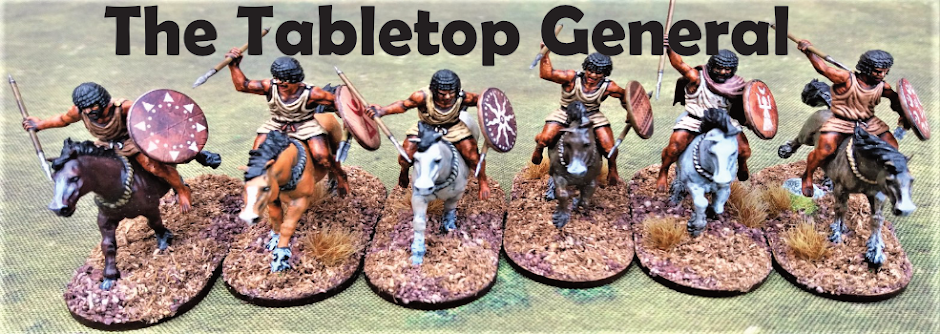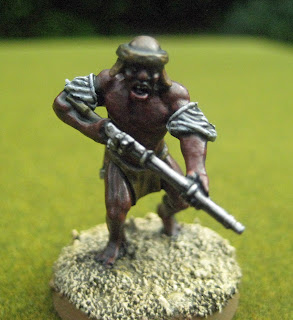 When I first decided to start wargaming World War II, my primary objective was to do the whole project as cheaply as possible. I decided on 20mm, rather than 28mm, because figures are available for a reasonable cost, while still being big enough to paint without finally loosing what remains of my eye sight. I had also decided that I wasn't going to paint metal figures anymore and there is a wide choice of plastics on the market in the smaller scale. The figures I decided to use came from Valiant Miniatures. There are lots of reasons for not using Valiant, not least that they are 1/72 scale and therefore somewhat larger than most 20mm ranges. The figures themselves often suffer from being really badly produced and it can be difficult to figure out just exactly what is what or where equipment and webbing are supposed to be. Having said all that, you get no less than 68 hard plastic figures in a box which
When I first decided to start wargaming World War II, my primary objective was to do the whole project as cheaply as possible. I decided on 20mm, rather than 28mm, because figures are available for a reasonable cost, while still being big enough to paint without finally loosing what remains of my eye sight. I had also decided that I wasn't going to paint metal figures anymore and there is a wide choice of plastics on the market in the smaller scale. The figures I decided to use came from Valiant Miniatures. There are lots of reasons for not using Valiant, not least that they are 1/72 scale and therefore somewhat larger than most 20mm ranges. The figures themselves often suffer from being really badly produced and it can be difficult to figure out just exactly what is what or where equipment and webbing are supposed to be. Having said all that, you get no less than 68 hard plastic figures in a box which will cost you £10.99, if you buy from the
will cost you £10.99, if you buy from theValiant web site, which equates to approximately 16p per figure! Of course, if you keep a close watch on e-bay, you can get them for even less than that. At that price, you have to forgive the odd dodgy figure. The figure on the right is one of my engineers and I think you can see that they do paint up pretty well.
My figures represent a battalion from the 916th Grenadier Regiment, which was based in Normandy in 1944, as part of the 352nd Infantry Division. The division didn't last long after D-Day before it was de-activated, following heavy fighting against the Americans, but I chose it because I think it probably represents a unit made up of ordinary Wehrmacht soldiers just doing their best to survive. Most of my figures come from the Classic German Infantry set and are painted in Vallejo 920 Reed Green, to suggest that they aren't quite at the forefront of the Wehrmacht's supply system and are still fighting in their early war uniform, rather than the new Field Grey version usually associated with late war German infantry.
 The late war infantry battalion consisted of a HQ Company, which in Rapid Fire terms is an officer and 5 other figures. The three rifle companies each have 8 figures, including an officer and a panzerfaust. The 4th, heavy weapons company, has 2 MG42s and an 81mm mortar, each with a crew of 3, giving a total of 39 figures for the battalion.
The late war infantry battalion consisted of a HQ Company, which in Rapid Fire terms is an officer and 5 other figures. The three rifle companies each have 8 figures, including an officer and a panzerfaust. The 4th, heavy weapons company, has 2 MG42s and an 81mm mortar, each with a crew of 3, giving a total of 39 figures for the battalion. Of course, to give the battalion any chance of standing up to the immense fire power of the Allies, there are options which can be drawn from various regimental or divisional sources to add extra punch. Thus far, my battalion is supported by a 75mm Infantry Gun with 3 crew, a section from the 14th Anti-Tank company with 2 figures and a composite company of engineers and recce infantry which belongs to the regimental HQ (10 figures in total).

The battalion H.Q. The commanding officer with his staff and that all important radio operator.

1st Company.
2nd Company.

3rd Company.
With various additional weapons, heads and bits of kit, it's fairly straightforward to produce simple conversions to create units with individual character.

4th Heavy Weapons Company.
A close up of the 81mm mortar and crew. In Rapid Fire, a mortar can decimate the opposition.

The 75mm infantry gun with three man crew.

At the moment, I have only painted up these two chaps from the Anti-tank company, but they add a definite punch when faced by Allied armour.
Artillery observers are essential if your artillery is going to be effective.
 These guys belong to the regimental H.Q., but I've fielded them with my battalion. 5 of the figures are engineers and the other 5 are reconnaissance troops.
These guys belong to the regimental H.Q., but I've fielded them with my battalion. 5 of the figures are engineers and the other 5 are reconnaissance troops.
The commanding officer of my reconnaissance troops. The figures in the 'Germans in Normandy' set are full of character and give you the scope to play around with different painting styles. This figure has field grey tunic and cammo trousers. I've always been a bit worried about painting cammo, but there are some really good guides available at the Artizan designs web site.

Artizan Designs Web Site Painting Guides.
Another member of the Recce Section, with painting based on the guides available on the Artizan web site.
So, that is my reinforced infantry battalion for Rapid Fire. There are more options yet to be added, but, as it is, it makes a very effective fighting force, capable of holding its own against most Allied forces of comaparable size.
Remember... you can click on any of the images to get a much bigger picture to look at.

























.JPG)
.JPG)
.JPG)


